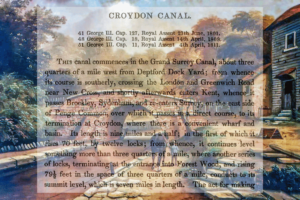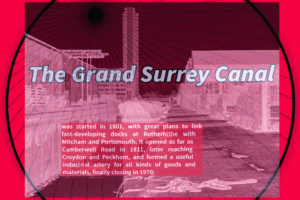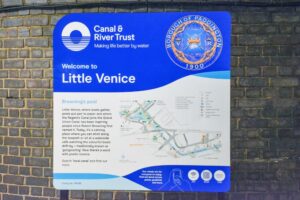The abortive lift scheme on the Regent’s Canal
Before any locks were built on the Regent’s Canal, problems with acquiring a reliable water supply, forced the company to look at other methods of transferring boats from one level to another. This came in the form of Congreve’s lift which existed at Camden between 1814 and 1819. It was an experiment that failed, and conventional locks were finally built.
Congreve’s lift delayed the opening of the Regent’s Canal as a through route to Limehouse by several years. It was located by where Camden lock – aka Hampstead Road locks – can be found.
Background to the hydro lock scheme
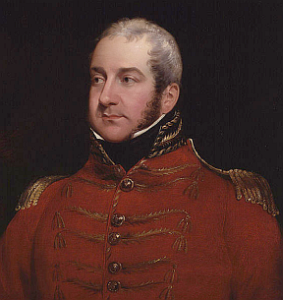
Sir William Congreve 1772-1828 (Wikipedia).
Sir Willliam Congreve was best known as England’s first rocket man. He worked for the ordnance and part of his work was to develop rockets for military use. His father was Superintendent of the Woolwich’s Royal Military Repository. Congreve developed an early interest in engineering through his father’s interest in military hardware.
Instead of becoming a military engineer like his father, Congreve at first became a newspaper publisher, overseeing the ‘Royal Standard and Political Register.’ This was soon enveloped in scandal and a libel case soon ended it. Congreve turned to the military and became employed as one if its major engineers.
Congreve was “abounding in ingenious ideas” and developed many devices such as rockets, flares, special clocks, gas meters, colour printing presses, and perhaps most ambitious of all, a perpetual motion machine. One of Congreve’s most bizarre inventions, ‘The Grand Revolving Temple of Concord’ was demonstrated in London’s Green Park during 1814.
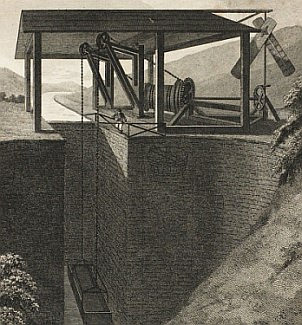
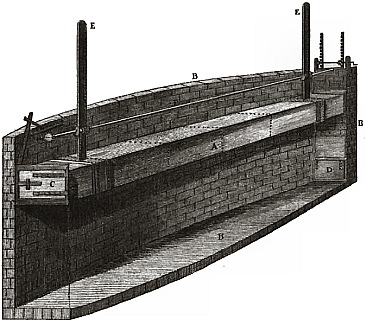
Fulton’s designs 1796 for a boat lift. Right: Weldon’s design used on the Somerset Coal Canal. The picture doesnt really show the enormous scale of Weldon’s design, which involved a huge shaft in the hillside with an approach tunnel at its base.
The hydro-pneumatic double balance lock as Congreve called it, was one of these failures. Attempts had been made to devise something that could raise or lower boats without wasting water, and Roberts Fulton & Weldon, James Green & Fussell, John Duncombe all tried various ways of lifting boats from one level to another. The only person with any success was James Green whose boat lifts worked the Grand Western Canal from the 1830’s to 1860’s.
It was not until the later part of the 19th Century that we saw reliable structures built capable of large tonnages such as the Anderton lift and Barton’s swing aqueduct. And of course the world-famous Falkirk Wheel in the 21st Century.
The history of the Regent’s Canal actually begins well before it’s inception when Robert Weldon’s Hydrostatick Caisson Lock (as some say, clearly an early type of submarine preceeding Nautilus by several years) came into use during the 1790’s on the Shropshire Canal. The then Prince Regent (George III) saw a demonstration of Weldon’s design on the Somersetshire Coal Canal and was clearly impressed with it.
The Regent’s Canal had originally aspired to use locks, but the concerns of water supply forced the company to look at alternatives. It is certain that the company was aware of the cassion lifts, perhaps on the suggestion of the Prince Regent.

Hampstead Road locks in Camden, London – the site of Congreve’s Hydro-pneumatic double balance lock.
Hydro-pneumatic canal lift – construction and failure at Hampstead Road
Congreve does not seem to have had any previous canal credentials (other than being described as ‘canal mad’ in one report from 1813.) He had been equerry to the Prince Regent, George IV since 1811, and a great favourite of his. With these credentials it is perhaps that somehow the Prince Regent was aware of his precessdor’s observations upon the Somersetshire canal’s cassion lock, hence the link to Congreve’s invention.
It may well have been the Prince Regent himself who prompted the canal engineer James Morgan to favour Congreve’s patent in a report made in April 1814. Clearly the company were impressed as it would save both water and valuable boatmen’s time. Congreve was offered £250 for each hydro-pneumatic lock successfully built.
Congreve’s patent, dated 23 March 1813, states “To all to whom these presents shall come, &c. Now know ye, that in compliance with the said provisio, I the said William Congreve, do decalre my said inventions to be performed in manner following; that is to say: My first mode of passing floating bodies from one level to another, by what I call the hydro-pneumatic double balance lock, is thus constructed.”
It is obvious that by this point somewhat Congreve had an overview of the various attempts at building a canal lift and thought he could do better by making one that looked much like an ordinary lock.
The hydro-pneumatic lock, as Congreve claims, was designed to be operated by one man in just three minutes, or by two men in a minute, without any loss of water.
Diagram (based on Congreve’s drawings) showing how the hydro-pneumatic lift would have worked. The Regent’s Canal Compnay changed the design to a longitidual arrangement which made it more difficult to operate.
It consisted of a pair of inverted cassions built entirely from wrought and cast iron. These worked in balance with each other. Just like an ordinary lock it had gates at both ends. Instead of a brick invert, a moveable bottom raised the water level up or down as required, assisted by air pressure. When one considers the problems Brunel had with the seals on his atmospheric railway in Devon several decades later, the creation of something with tight clearances such as Congreve’s lifts required watertight seals working under extreme pressure. This technology was not actually attainable at the time but Congreve still had every confidence his structure would be made to work.
For some reason the Regent’s Canal Company demanded changes to the design of the hydro-pneumatic lock which made it more complicated. Work began at Camden on 14 October 1814 to build what could now be considered a see-saw hydro-lock in place of Congreve’s original design. This greatly modified structure was built by Henry Maudslay and Co, a noted engineering company whose later successes included the beam engines at Kew. The company was based in Westminster Bridge Road, this being most convienent for overseeing construction of the new structure.
Part of the task involved the use of air cylinders to pressurise the cassions. The lock-keeper’s house at Hampstead Road, now a Starbuck’s, was originally built in 1815 to house this air compression equipment.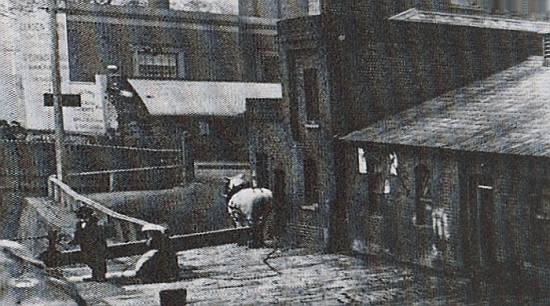
Remains from Congreve’s Hydro canal lift. The lock house and adjacent lean-to seen in 1876.
The canal hoped the lift would be operational by March 1815. Many technical problems were encountered because of the company’s change to the original design, and the deadline for making the lift operable was missed. It was around a full year later before it finally worked. Demonstrations were given usually twice weekly on Tuesdays and Thursdays. Noted canal engineers such as Josias (sometimes spelt Josiah) Jessop and John Rennie jnr visited Camden to observe the operation of the hydro-pneumatic lock.
It was physically demanding to operate, and staff were “incapable of further exertion for a considerable time after.” Further a continual staff presence was required to keep the cassions in a state of readiness and their wages had to be paid. Congreve’s claims that the lock could be worked in a matter of minutes was never completely validated and the canal company made a lot of fuss over this. The time expended in operating the lock was a factor that prompted the company to look towards use of ordinary locks.
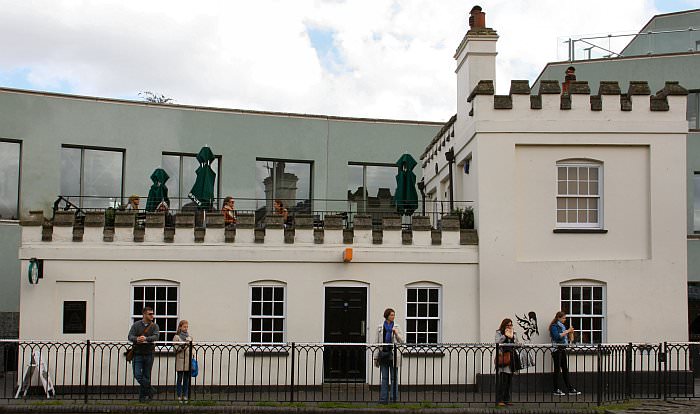
The modified & castellated lock keeper’s house at Hampstead Road, now Starbucks. Originally built for the hydro-pneumatic lift.
There were problems with the seals that made the 26 and half ton cassions watertight. This and ther issues of construction were blamed upon Maudslays. It refuted the accusations, claiming that the canal company was at fault as it had been responsible for the structure since October 1816, and records showed the lift had worked perfectly in the six months prior to the handover. An apparent lack of maintenance by the canal company caused the cassions to distort and at least one pressurised air piston broke, putting the machine out of work for a few months.
In December 1817 Congreve offered to correct the damage at his own expense. Additionally a two-horsepower engine was built to assist with the operation of the cassions. Mindful of ever-increasing expenses, the canal company decided to cut its losses and proceed with normal locks. On 1 July 1818 the canal company informed Congreve his hydro-pneumatic double balance design could not be used. The company hoped Congreve would find a use for it elsewhere.
The lift was put on sale in October 1818. The bidder was not satisfactory to the canal company for some unknown reason and his bid of £100 was eventually turned down and he was asked to pay £150 and remove the canal lift immediately in July 1819. The bidder declined.
It was finally put up for auction in November 1819 bundled in thirteen lots. A condition of sale was purchasers were responsible for removing the parts. Any unnecessary damage caused to the canal would incur a penalty payable to the canal company for said damage. Just £404 pounds was raised from the sale of Congreve’s lift. It is quite possible that bits of the lift remained on site until at least the early part of 1820.
In the sale notice someone (from the canal company known only as ‘JD’) has written at the top “Congreves Pneumatic Lock!!! A Humbug.” At the bottom was written “thus ended SWC’s humbug at the cost to the company of many thousands of pounds.”
The Camden Hydro-Pneumatic Canal Lift – Epilogue
Whilst there were many problems with the design and operation of the hydro-pneumatic double balance lock, it appears considerable fault lay with the Regent’s Canal Company. Firstly Congreve had envisaged a lock with two cassions side by side in good balance. The canal company changed this to two half locks, one in front of the other, so instead of having a full drop of 7ft, each cassion only dropped 3ft six inches. This reduced the operating capability of the canal lift considerably.
The canal company’s changes meant an additional gate was needed, and no doubt the more complicated arrangement added enormous stresses on the operating equipment. The greater distance between the cassions, induced a drop in pressure because the compressed air had to travel further and this was beyond the remit of the original designs for the use of compressed air. The canal company had always hoped the operation would take no more than three minutes, but that was strictly within the original design’s remit. The modified design took much longer, was more complex, and demanded further machinery to make the entire structure work effectively. The company were extremely disappointed at the extended operating times – but had brought this about themselves.
The Regent’s Canal Company were glad to see the back of Congreve’s canal lift. No wonder they saw it as humbug. But it was they who changed the design, inducing extra complications into the build of the structure. Both Congreve and Henry Maudslay & Co. attempted to correct things at their own expense. Maudslays alone expended around £10,000 – a lot of money at the time.
Regent’s Canal pages:
Introduction & Little Venice-Maida Hill / Maida Hill-London Zoo / Cumberland Turn-Pirate Castle / Camden-St Pancras / Congreve’s Canal Lift at Camden / King’s Cross-Acton’s Lock / Mare Street-Limehouse
